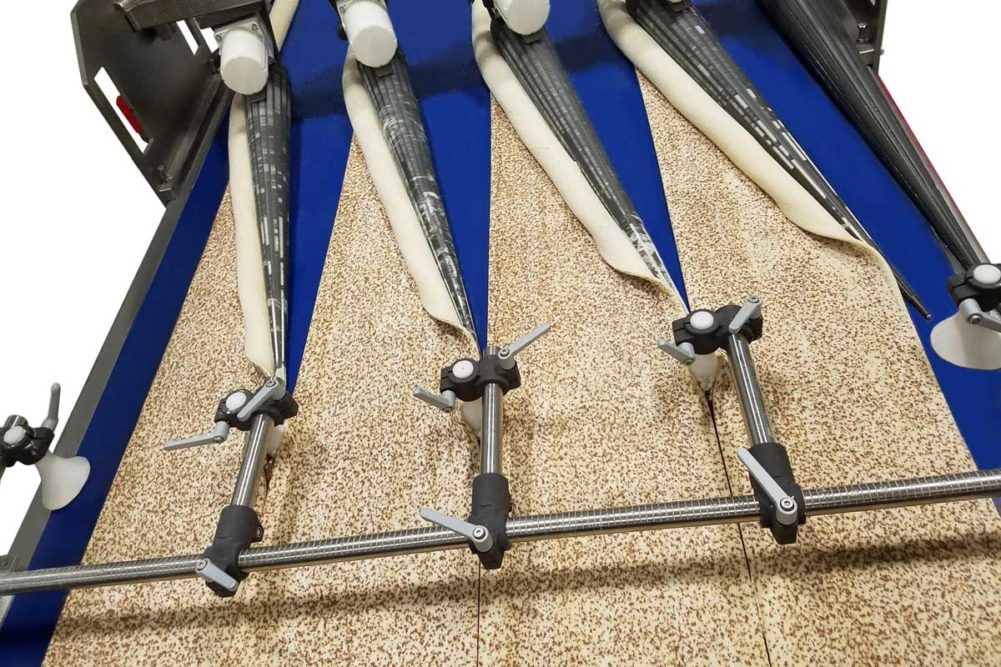Integrated technology plays a key role in ensuring high-volume production of a large swath of sweet goods. On some advanced systems, it takes only one operator to call up the recipe before the entire line pivots to preset parameters for each part of the process.
Scott McCally, president of Auto-Bake, a Middleby Bakery company, pointed out that the company’s Serpentine System delivers less than 1% in process losses by operating without stopping or changing speeds from panning through baking and cooling to depanning.
“Each pan is on perfect pitch and runs single file through the entire system without touching, transferring or leaving at any point,” he said. “This ensures excellent product to pan target interface and the most consistent finished product quality in the industrial market.”
At many bakeries, the greatest amount of waste occurs after initially firing up the line following scheduled downtime. To quickly fine tune at the beginning of weekly production, David Moline, vice president, sales and marketing, Moline Machinery, recommended integrating standardized startup procedures into recipe controls.
Line speed should be aligned with automated gap adjustment settings for sheeting rollers. As production ramps up, skilled operators will then tweak the process to tailor it to flour quality, dough consistency and other variables.
“With the push of a button, everything can be baselined,” Mr. Moline said. “Having a starting point is critical no matter what you are doing. Depending on your product, that’s where the training comes in because no two doughs are created equal. Yeast doughs are alive, and they change depending on how fresh they are and when they’re used. So, you need trained eyes, and that’s where original equipment manufacturers can develop baselines for certain products and help train the operators’ eyes to make adjustments to keep your efficiencies as high as possible.”
Fritsch’s control panels provide data about line speed, production duration, capacity produced per shift, machine hours and even preventive maintenance reminders. Accessed by flash drive, printout or remote login, this data provides a valuable cross reference from the beginning of processing all the way to packaging.
“In mixing, you will be able to see the efficiency of what was produced based off of the batches made,” observed Randy Kelly, application specialists, Fritsch, a Multivac company. “In packaging, you can see how many products made it into a package and how efficient the entire processing line was.”
Mr. McCally pointed out that a single encoder on an Auto-Bake system communicates the production speed and position of systems ranging from pan oiling, paper cup denesting and batter depositing to topping and cream injection.
He added that an industrial PC acts as performance historian, which logs start cycles, runtimes, utility consumption, faults, parameter changes by log in and time, to name a few. The computer also provides access to manuals, drawings, how-to videos and maintenance’s standard operating procedures.
Mr. Moline said automated roller gap adjustments and dough tension monitoring systems provide much-needed consistency on versatile lines with a bevy of product changeovers.
“It’s difficult to be a true expert with every single product because there are so many of them as opposed to a [dedicated] purpose-built line,” he said. “So, investing in automation is important for lines that are designed for a lot of SKUs right out of the gate.”
On sheeting lines, Mr. Moline added, the goal is to identify bottlenecks and maximize throughput.
“Usually, that’s not the sheeting line,” he said. “Usually, it’s going to be oven capacity and bake time. The ovens can only go so fast because the products have to bake for a certain number of seconds. Or maybe it’s packaging. If a baker is looking to add capacity, their bottleneck is where they can upsize and add capacity incrementally.”
Adding bite-sized sweet goods to a portfolio requires adjustments to the process and even retooling or investments in equipment, such as more complex injection systems if the new snack cakes require fillings.
“The only challenge is there are a lot more needles because the product is smaller so there are more rows across, such as 24 across instead of 16 or 18,” said Bob Peck, vice president of engineering, E.T. Oakes.
When turning out minis, bakers must account for smaller needle sizes and the even distribution of crème to a greater number of tiny treats.
“It’s a little challenging, but we’ve done it enough times where we have addressed the distribution issues and proper needle size on a variety of crèmes,” Mr. Peck said.
Viscous fillings such as peanut butter or caramel also need preheating in jacketed vats and tanks from 100 to 130˚F to make them flow properly. To maintain those temperatures, all the piping as well as the injector’s aluminum manifold requires 150˚F hot water jacketing, especially if a thermocouple indicates the filling’s temperature has fallen below its setpoint value.
Slowing down to work faster is also pertinent with spot depositing.
“You want to make sure everything is synchronized perfectly,” Mr. Moline said. “Otherwise, you will have a mess on your hands. When you’re dealing with eight lanes of production instead of four, the complexity is just multiplied. You may not have more pounds-per-hour throughput, but you’re dealing with a greater number of moving parts and areas that you must pay attention to. That’s where slower, sometimes, does make it more manageable.”
To maintain high yields, Mr. Moline added, focus on preventive maintenance to make sure all the lines are operating like the equipment was intended to run, even if the equipment is not new.
This article is an excerpt from the May 2020 issue of Baking & Snack. To read the entire feature on sweet goods tech, click here.





